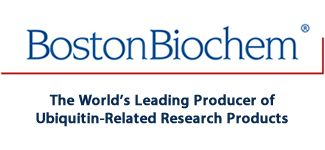
Recombinant Human UbcH10/UBE2C Protein, CF Summary
Recombinant Human UbcH10/UBE2C is a member of the Ubiquitinconjugating Enzyme (E2) family that receives Ubiquitin from a UbiquitinActivating Enzyme (E1) and subsequently interacts with a Ubiquitin ligase (E3) to conjugate ubiquitin to substrate proteins. Reaction conditions will need to be optimized for each specific application. We recommend an initial UbcH10/UBE2C concentration of 0.1-1 μM.
Product Datasheets
Carrier Free
CF stands for Carrier Free (CF). We typically add Bovine Serum Albumin (BSA) as a carrier protein to our recombinant proteins.Adding a carrier protein enhances protein stability, increases shelf-life, and allows the recombinant protein to be stored at a more dilute concentration.The carrier free version does not contain BSA.
In general, we advise purchasing the recombinant protein with BSA for use in cell or tissue culture, or as an ELISA standard.In contrast, the carrier free protein is recommended for applications, in which the presence of BSA could interfere.
E2-654
| Formulation | 0.50 mg/ml (25 μM) in 50 mM HEPES pH 7.0, 200 mM NaCl, 10% Gycerol (v/v), 1 mM TCEP |
| Shipping | The product is shipped with dry ice or equivalent. Upon receipt, store it immediately at the temperature recommended below. |
| Stability & Storage: | Use a manual defrost freezer and avoid repeated freeze-thaw cycles.
|
Reconstitution Calculator
Background: UbcH10/UBE2C
Ubiquitinconjugating Enzyme H10 (UbcH10), also known as Ubiquitinconjugating Enzyme E2C (UBE2C), is a 179 amino acid (aa) member of the yeast Ubc4/5 family of UbiquitinConjugating Enzymes (E2) and has a predicted molecular weight of 20 kDa. Human UbcH10/UBE2C shares 96% aa sequence identity with mouse and rat UBE2C. UbcH10/UBE2C is an essential mediator of mitotic destruction events and cell cycle progression. UbcH10/UBE2C recognizes TEK sequences in target proteins such as Cyclins A and B, mediates Lys11linked ubiquitination, and promotes target protein degradation in conjunction with APC/C, a Ubiquitin Ligase (E3). The catalytic activity of UbcH10/UBE2C is regulated by a conserved Nterminal extension, which mediates E2E3 interaction. UbcH10/UBE2C is overexpressed in a variety of human cancers, and alternate splice isoforms may contribute to uncontrolled cell proliferation and tumor progression.
- Dimova, N.V. et al. (2012) Nat. Cell Biol. 14: 168
- Hao, Z. et al. (2012) Tumor Biol. 33: 723
- Jiang, L. et al. (2008) Brain Res. 1201: 161
- Lin, Y. et al. (2002) J. Biol. Chem. 277: 21913
- Okamoto, Y. et al. (2003) Cancer Res. 63: 4167
- Summers, M.K. et al. (2008) Mol. Cell 31: 544
- van Ree, J.H. et al. (2010) J. Cell Biol. 188: 83
- Ye, Y. & M. Rape (2009) Nat. Rev. Mol. Cell Biol. 10: 755
Citations for Recombinant Human UbcH10/UBE2C Protein, CF
R&D Systems personnel manually curate a database that contains references using R&D Systems products.The data collected includes not only links to publications in PubMed,but also provides information about sample types, species, and experimental conditions.
5Citations: Showing 1 - 5Filter your results:
Filter by:
- PI5P4K? functions in DTX1-mediated Notch signalingAuthors: L Zheng, SD ConnerProc. Natl. Acad. Sci. U.S.A., 2018;0(0):.Species: HumanSample Types: Recombinant ProteinApplications: Bioassay
- Plk1 phosphorylation of CAP-H2 triggers chromosome condensation by condensin II at the early phase of mitosisAuthors: Y Kagami, M Ono, K YoshidaSci Rep, 2017;7(1):5583.Species: N/ASample Types: ProteinApplications: Bioassay
- Proteasome inhibition enhances the efficacy of volasertib-induced mitotic arrest in AML in vitro and prolongs survival in vivoAuthors: D Schnerch, J Schüler, M Follo, J Felthaus, D Wider, K Klingner, C Greil, J Duyster, M Engelhardt, R WäschOncotarget, 2017;8(13):21153-21166.Species: HumanSample Types: Whole CellsApplications: Bioassay
- Plk1 phosphorylation of CAP-H2 triggers chromosome condensation by condensin II at the early phase of mitosisAuthors: Y Kagami, M Ono, K YoshidaSci Rep, 2017;7(1):5583.Species: HumanSample Types: Recombinant ProteinApplications: Bioassay
- Neddylation E2 UBE2F promotes the survival of lung cancer cells by activating CRL5 to degrade NOXA via the K11 linkageClin Cancer Res, 2016;0(0):.Species: HumanSample Types: ProteinApplications: Ubiquitination
FAQs
No product specific FAQs exist for this product, however you may
View all Proteins and Enzyme FAQsRecombinant Enzymes
Recombinant Human UbcH5a/UBE2D1 Protein, CF
Reviews for Recombinant Human UbcH10/UBE2C Protein, CF
There are currently no reviews for this product. Be the first toreview Recombinant Human UbcH10/UBE2C Protein, CF and earn rewards!
Have you used Recombinant Human UbcH10/UBE2C Protein, CF?
Submit a review and receive an Amazon gift card.
$25/€18/£15/$25CAN/¥75 Yuan/¥1250 Yen for a review with an image
$10/€7/£6/$10 CAD/¥70 Yuan/¥1110 Yen for a review without an image
ebiomall.com






>
>
>
>
>
>
>
>
>
>
>
>
启动子是RNA聚合酶能够识别并与之结合,从而起始基因转录的一段DNA序列,通常位于基因上游.一个典型的启 动子包括CAAT-box和TATA-box,它们分别依赖DNA的RNA聚合酶的识别和结合位点,一般位于转录起始位点上游几十个碱基处.在核心启动子上 游通常会有一些特殊的DNA序列,即顺式作用元件,转录因子与之结合从而激活或抑制基因的转录.一旦RNA聚合酶定位并结合在启动子上即可 启动基因转录,因此启动子是基因表达调控的重要元件,它与RNA聚合酶及其他蛋白辅助因子等反式作用因子的相互作用是启动子调控基因转录的实质.
根据启动子的转录模式可将其分为3类:组成型启动子、组织或器官特异性启动子和诱导型启动子.
似乎都是鉴定目的基因是否导入受体细胞 没有鉴定是否成功导入质粒的 鉴定目的基因是否导入受体细胞有四个层次 1 直接鉴定受体细胞中是否有目的基因 用DNA分子杂交 2 鉴定目的基因是否转录 分子杂交(mRNA) 3 目的基因是否表达 抗原-抗体 (蛋白质) 4 看受体细胞发育成的个体是否表现出相关性状
各位大神,我现在用PET28α作为表达载体,在连接的时候是不是载体要进行双酶切、胶回收?我双酶切的目的片段和PET28α连接后,导入感受态中没有成功,不知道怎么回事,请教各位。
2、基因表达载体的构建
(1)目的:使目的基因在受体细胞中稳定存在并且可以遗传给下一代并表达和发挥作用.(2)基因表达载体的组成:目的基因+启动子+终止子+标记基因
②启动子在基因的首段,它是RNA聚合酶的结合位点,能控制着转录的开始,故②正确;
③终止子在基因的尾端,它控制着转录的结束,故③正确;
④由于受体细胞有植物、动物以及微生物之分,以及目的基因导入受体细胞的方法不同,因此基因表达载体的构建是不完全相同的,









